數據結構(四)--- 紅黑樹(RedBlock-Tree)
文章圖片來自鄧俊輝老師課件
先提幾個問題去思考學習本文 :
- 紅黑樹和2-4樹(B-Tree)很像,那麽它存在的動機又是什麽呢
- 插入和刪除操作的邏輯又是怎麽樣的,時間和空間復雜度可以達到怎麽樣
- 和 AVL 對象有什麽區別呢
概述
定義

我們可以看到紅黑樹有4條重要的定義,這4條定義保證了這個平衡樹。下面我們看一下它和B-Tree的聯系。

從這個結構上說,我們可以知道B-Tree相比於紅黑樹,紅黑樹需要維護一個顏色這樣的屬性,需要空間,而同時紅黑樹搜索時可以
像二叉樹一般查找,而B-Tree每一個超級節點需要維護多個關鍵碼。這方面查看 RST_WIKI 這裏的分析。
但是這樣的樹是BBST嗎?

上面的數學推算已經向我證明,平均的深度為 h = O(LogN)
動機
Persistant Structure 一致性
下面介紹了紅黑樹為什麽適應一致性結構。

時間和空間復雜度紅黑樹可以適應條件。同時拓撲結構上,無論是插入還是刪除,都可以不超過O(1).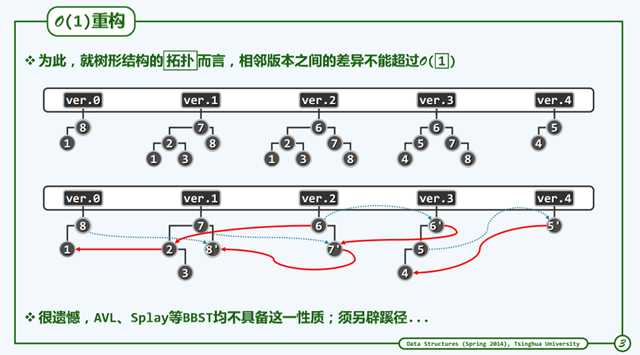
最壞情況下保證插入和刪除,查找
這裏引用 wiki 上的一段話說明紅黑樹在這方面的表現。
Red–black trees offer worst-case guarantees for insertion time, deletion time, and search time. Not only does this make them valuable in time-sensitive applications such as real-time applications, but it makes them valuable building blocks in other data structures which provide worst-case guarantees; for example, many data structures used in computational geometry can be based on red–black trees, and the Completely Fair Scheduler used in current Linux kernels and epoll system call implementation[19]
uses red–black trees.
時間空間復雜度
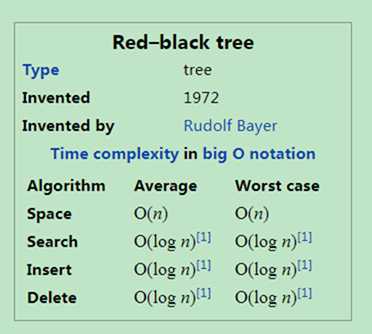
出處見參考資料
插入原理解析
我們定義插入的節點為紅色,那麽就有一種情況,雙紅,這違反了我們前面紅黑樹的定義,下面介紹如何解決雙紅問題。
RR-1
第一種情況 u 節點(uncle節點)是黑色的。

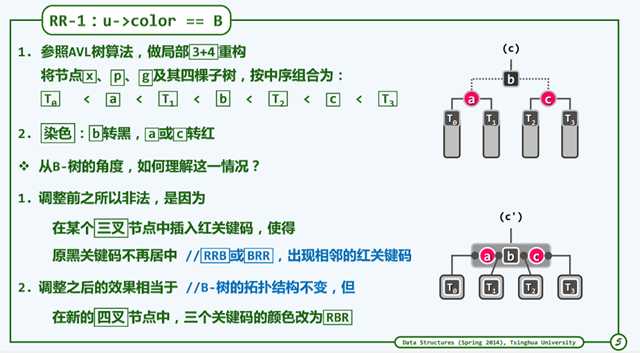
我們可以使用3+4實現,讓樹消除雙紅現象,3+4實現可以參考這篇文章 : 3+4
RR-2
u節點是紅色的情況下,最終可能導致樹高度+1
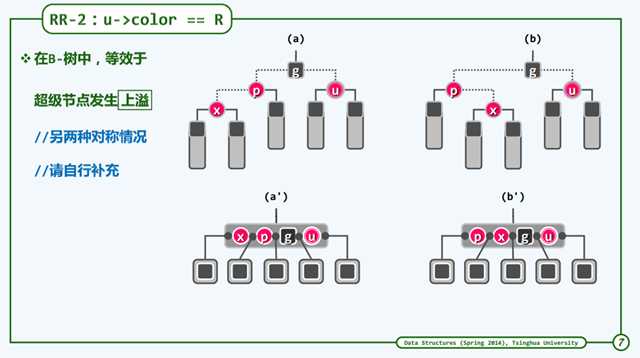
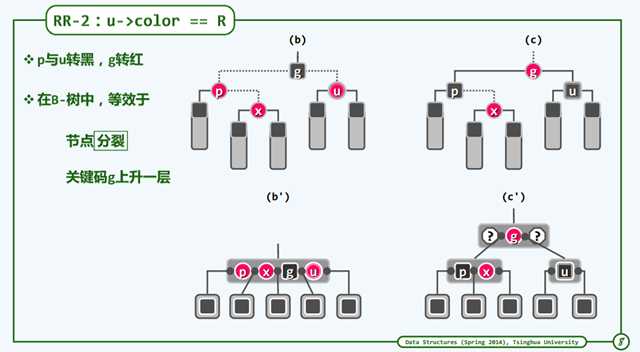
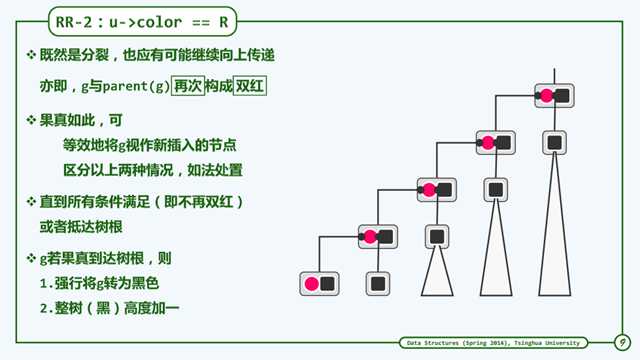
插入歸納

刪除原理解析
我們思考一下,假如先不看顏色,那麽二叉樹的刪除算法中,考察三種情況
- 擁有其中一個子節點
- 無子節點
- 擁有左右子節點
其中第一和第二種情況很好處理,直接刪除即可,有其中一個子節點需要重新連接一下父節點。第三種需要找出繼承節點,然後替
換掉刪除節點。繼承節點簡單點解釋就是右樹中最小的一個。
好了,那麽此時我們再來思考一下顏色的問題,我們知道紅黑樹不能紅紅相聯,且每個底部節點到根節點黑節點的數量都相等,要
是刪除節點是上面第一種情況和第二種情況且刪除節點是紅節點,直接刪除對樹的平衡沒有情況影響。
那麽要是刪除節點和繼承節點一黑一白呢,我們只需將刪除後,將繼承節點染黑就可以了,見下圖。

那麽刪除節點和繼承節點都是黑的情況呢?
雙黑缺陷
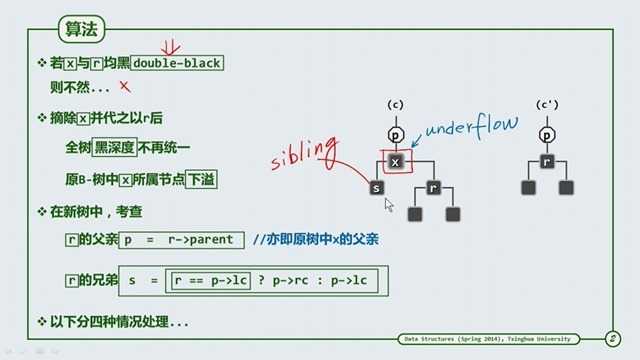
可以看到,當刪除節點和替代節點都為黑節點,刪除會產生下溢(下溢的概念可以參考上篇B-樹),需要考察繼承節點的父節點p和
兄弟節點 s ,下面分四種情況處理 :
BB-1

a’ 和 b’ 都是B-Tree 的撲拓結構,可以看到當s擁有一個紅節點時,產生下溢的節點通過旋轉,向兄弟節點借來了一個節點,從而
達到了平衡。而從 a 到 b 的過程,需要借助的是3+4操作。
BB-2R

BB-2R的情況,就相當於B-Tree的合並,而我們看到最終的撲拓結構是不變的,只需要進行染色,那麽當父節點被拿走了一個,是否會產生下溢呢?不會,因為在父節點中有紅節點,那麽左或右必有黑節點。
BB-2B

同樣也是合並操作,此時不是像BB-2R一樣是紅色節點了,那麽就有可能引發下沈下溢,那麽是不是會像AVL一樣進行LogN次的旋轉操作呢?不會,從a到b,我們可以他們的撲拓結構沒有改變,改變的只是顏色,所以不會發生LogN次的旋轉。時間復雜度依舊是O(1).
BB-3

可以看到,經過了左旋或是右旋,還有變色,由a到b後,黑高度依舊異常,可以有一個好消息就是,經過旋轉變成了我們之前處理
的情況一樣,即 BB-1 或是 BB-2R ,不會是 BB-2B的原因是 x 有個新的兄弟節點 s’ ,而且 p 為紅節點。
至此,我們雙黑的情況全部介紹完畢。
歸納總結和AVL的對比

代碼實現
代碼實現我們以java中的TreeMap 來解釋。本文只會介紹刪除操作。
/**
* Removes the mapping for this key from this TreeMap if present.
*
* @param key key for which mapping should be removed
* @return the previous value associated with {@code key}, or
* {@code null} if there was no mapping for {@code key}.
* (A {@code null} return can also indicate that the map
* previously associated {@code null} with {@code key}.)
* @throws ClassCastException if the specified key cannot be compared
* with the keys currently in the map
* @throws NullPointerException if the specified key is null
* and this map uses natural ordering, or its comparator
* does not permit null keys
*/
public V remove(Object key) {
Entry<K,V> p = getEntry(key);
if (p == null)
return null;
V oldValue = p.value;
deleteEntry(p);
return oldValue;
}
/**
* Returns this map‘s entry for the given key, or {@code null} if the map
* does not contain an entry for the key.
*
* @return this map‘s entry for the given key, or {@code null} if the map
* does not contain an entry for the key
* @throws ClassCastException if the specified key cannot be compared
* with the keys currently in the map
* @throws NullPointerException if the specified key is null
* and this map uses natural ordering, or its comparator
* does not permit null keys
*/
final Entry<K,V> getEntry(Object key) {
// Offload comparator-based version for sake of performance
if (comparator != null)
return getEntryUsingComparator(key);
if (key == null)
throw new NullPointerException();
@SuppressWarnings("unchecked")
Comparable<? super K> k = (Comparable<? super K>) key;
Entry<K,V> p = root;
while (p != null) {
int cmp = k.compareTo(p.key);
if (cmp < 0)
p = p.left;
else if (cmp > 0)
p = p.right;
else
return p;
}
return null;
}
/**
* Delete node p, and then rebalance the tree.
*/
private void deleteEntry(Entry<K,V> p) {
modCount++;
size--;
// If strictly internal, copy successor‘s element to p and then make p
// point to successor.
if (p.left != null && p.right != null) {
Entry<K,V> s = successor(p);
p.key = s.key;
p.value = s.value;
p = s;
} // p has 2 children
//到了這裏,無論p是有幾個孩子,p這個變量變成了要刪除的節點
//要是 p有兩個child,會進入上面那個if,p變為了繼承節點
// Start fixup at replacement node, if it exists.
Entry<K,V> replacement = (p.left != null ? p.left : p.right);
if (replacement != null) { //只存在一個子節點
// Link replacement to parent 重新連接父節點,需要刪除的節點置為 null
replacement.parent = p.parent;
if (p.parent == null)
root = replacement;
else if (p == p.parent.left)
p.parent.left = replacement;
else
p.parent.right = replacement;
// Null out links so they are OK to use by fixAfterDeletion.
p.left = p.right = p.parent = null;
// Fix replacement 開始修復,判斷是不是黑節點是因為紅節點直接刪除沒有影響 :
// 每個底部節點到根節點的黑色節點數量相等
if (p.color == BLACK)
fixAfterDeletion(replacement);
} else if (p.parent == null) { // return if we are the only node. 該樹只有一個節點
root = null;
} else { // No children. Use self as phantom replacement and unlink. 沒有子節點
if (p.color == BLACK) //繼承節點為黑
fixAfterDeletion(p);
if (p.parent != null) { //繼承節點為紅,直接刪除
if (p == p.parent.left)
p.parent.left = null;
else if (p == p.parent.right)
p.parent.right = null;
p.parent = null;
}
}
}
// 實際就是解決雙黑節點的問題
/** From CLR */
private void fixAfterDeletion(Entry<K,V> x) {
while (x != root && colorOf(x) == BLACK) { //非根且為黑節點
if (x == leftOf(parentOf(x))) {
Entry<K,V> sib = rightOf(parentOf(x)); //取右兄弟節點
if (colorOf(sib) == RED) {
setColor(sib, BLACK);
setColor(parentOf(x), RED);
rotateLeft(parentOf(x));
sib = rightOf(parentOf(x));
}
if (colorOf(leftOf(sib)) == BLACK &&
colorOf(rightOf(sib)) == BLACK) {
setColor(sib, RED);
x = parentOf(x);
} else {
if (colorOf(rightOf(sib)) == BLACK) {
setColor(leftOf(sib), BLACK);
setColor(sib, RED);
rotateRight(sib);
sib = rightOf(parentOf(x));
}
setColor(sib, colorOf(parentOf(x)));
setColor(parentOf(x), BLACK);
setColor(rightOf(sib), BLACK);
rotateLeft(parentOf(x));
x = root;
}
} else { // symmetric //和前面是對稱的
Entry<K,V> sib = leftOf(parentOf(x)); // x是左節點
if (colorOf(sib) == RED) { //假如是BB-3,旋轉後只能是 BB-1 或者是 BB-2R
setColor(sib, BLACK);
setColor(parentOf(x), RED);
rotateRight(parentOf(x));
sib = leftOf(parentOf(x));
}
if (colorOf(rightOf(sib)) == BLACK && //BB-2R 或是 BB-2B
colorOf(leftOf(sib)) == BLACK) {
setColor(sib, RED);
x = parentOf(x);
} else {
if (colorOf(leftOf(sib)) == BLACK) { //BB-1 中 紅在右邊
setColor(rightOf(sib), BLACK);
setColor(sib, RED);
rotateLeft(sib);
sib = leftOf(parentOf(x));
}
setColor(sib, colorOf(parentOf(x)));
setColor(parentOf(x), BLACK);
setColor(leftOf(sib), BLACK);
rotateRight(parentOf(x));
x = root; //跳出while
}
}
}
setColor(x, BLACK);
}
參考資料
- 鄧俊輝老師數據結構課程
- RST_WIKI
數據結構(四)--- 紅黑樹(RedBlock-Tree)
